Published
- 7 min read
What you need to know about electric vehicle batteries

Electric vehicles (EVs) are transforming the transportation industry, driven by the need for cleaner, more sustainable energy sources. At the heart of this revolution is the electric vehicle battery — the component that powers the vehicle and enables it to operate without the need for traditional fossil fuels. In this article, we’ll take a comprehensive look at electric vehicle batteries, how they work, how long they last, what happens to them at the end of their life cycle, and how advancements in battery technology and recycling are shaping a more sustainable future for EVs.
How do electric vehicle batteries work?
Electric vehicle batteries are typically lithium-ion batteries, similar to the ones used in laptops and smartphones but much larger and more powerful. The battery stores energy in chemical form and then converts it into electrical energy to power the vehicle’s electric motor. Unlike internal combustion engines, which burn fuel to create power, electric motors use this stored electrical energy directly, making EVs significantly more efficient and eco-friendly.
An electric vehicle’s battery is composed of numerous cells organized into modules, which are then grouped into a pack. These cells are capable of storing large amounts of energy, giving the vehicle the ability to travel long distances without needing to recharge frequently. The energy density of lithium-ion batteries, which is higher than older battery technologies like lead-acid, is a key factor in their ability to power electric vehicles for hundreds of miles on a single charge.
The efficiency of these batteries also means that EVs typically have a quicker response time and smoother acceleration compared to traditional gasoline-powered vehicles.
Battery capacity and driving range
The capacity of an electric vehicle battery is measured in kilowatt-hours (kWh), a unit that describes how much energy the battery can store. This is akin to how the size of a gasoline tank is measured in gallons. The greater the battery’s capacity, the longer the vehicle can travel on a single charge. For example, small EVs like the Chevrolet Bolt typically have capacities ranging from 60 kWh to 75 kWh, which translates to driving ranges of 200 to 300 miles. Larger EVs, like the Rivian R1T, may have battery capacities that exceed 130 kWh, giving them ranges well over 300 miles.
However, driving range isn’t solely determined by the battery size. Other factors, such as driving habits, terrain, weather conditions, and the use of climate control systems, can impact how far an EV can travel on a full charge. Similarly, manufacturers often reserve a small portion of the battery’s capacity to prevent overcharging and extend its lifespan.
How long does it take to charge an EV battery?
Charging times for electric vehicle batteries vary depending on the battery’s size and the type of charger used. There are three main types of charging levels:
-
Level 1 (120-volt charging): This is the slowest charging method, which uses a standard household outlet. It can take up to 24 hours or more to fully charge an electric vehicle, as it only adds about 4-5 miles of driving range per hour of charging. This level is typically only practical for drivers who use their EV for short daily commutes.
-
Level 2 (240-volt charging): A much faster option, Level 2 chargers can add 20-40 miles of range per hour of charging. This makes them ideal for home charging setups or public charging stations, especially for overnight charging. Depending on the battery size, a full charge with a Level 2 charger can take between 4 to 10 hours.
-
Level 3 (DC fast charging): This is the fastest charging method, primarily available at public charging stations. DC fast chargers can replenish 80% of an EV battery in just 20-30 minutes, adding over 100 miles of range in that time. However, not all EVs are compatible with the highest charging speeds, and frequent use of fast chargers can degrade the battery more quickly over time.
Charging infrastructure continues to expand, with more Level 2 and Level 3 stations being installed in urban areas and along highways, making long-distance travel more feasible for EV drivers.
How much does it cost to charge an EV battery?
The cost to charge an electric vehicle depends on several factors, including where and when you charge, the local cost of electricity, and the size of the vehicle’s battery. Charging at home is usually the most economical option. For example, if your home electricity rate is $0.13 per kWh, it would cost about $8.45 to fully charge a 65 kWh battery like that of a Chevrolet Bolt, which offers around 250 miles of range.
Public charging stations vary in price, especially Level 3 fast chargers. Some public stations charge by the minute, while others charge by the kilowatt-hour. Fast charging is generally more expensive than home charging, but it provides the convenience of a quick energy boost when you’re on the road.
Many utility companies offer special rates for EV owners that reduce the cost of charging during off-peak hours (typically late at night), making it even more affordable for those who can charge at home.
How long do EV batteries last?
The lifespan of an electric vehicle battery is one of the most frequently asked questions by potential EV owners. Most EV batteries are designed to last between 8 to 15 years, depending on factors like the climate, driving patterns, and how often the vehicle is fast-charged. The U.S. Department of Energy suggests that, in moderate climates, EV batteries may last up to 20 years, though this number could be lower in extreme weather conditions.
Battery manufacturers are continually improving the technology to extend the lifespan of EV batteries. Many electric vehicles come with warranties that cover the battery for 8 years or 100,000 miles, providing peace of mind to consumers. Although EV batteries do degrade over time, their decline in performance is gradual. After about 10 years of use, a typical EV battery may still retain 70% to 80% of its original capacity.
When an EV battery reaches the end of its useful life for powering a vehicle, it can often still be used for other applications, such as energy storage for homes or businesses, prolonging its lifecycle before eventual recycling.
Battery recycling and sustainability
As the number of EVs on the road increases, the issue of battery recycling becomes more critical to ensuring that electric vehicles are as sustainable as possible. Lithium-ion batteries contain valuable materials like lithium, cobalt, and nickel, which can be recovered and reused in the production of new batteries. This not only reduces the demand for mining new resources but also minimizes the environmental impact of battery disposal.
Several companies and initiatives are already focusing on improving battery recycling processes. Redwood Materials and Li-Cycle are leading the way in the United States, developing systems that can recover up to 95% of the valuable materials from used EV batteries. These materials can then be reused, creating a circular economy for EV batteries and reducing waste.
In addition, governments around the world are implementing regulations to ensure that manufacturers take responsibility for the full lifecycle of their batteries. The European Union, for example, has introduced legislation requiring EV manufacturers to meet specific recycling targets and to design batteries that are easier to recycle.
Advancements in battery technology
Battery technology is rapidly evolving, with advancements that promise to make electric vehicles more efficient, affordable, and sustainable. Some of the most exciting developments in the field include:
-
Solid-state batteries: These batteries use a solid electrolyte instead of a liquid one, making them safer, faster to charge, and potentially longer-lasting. While still in development, solid-state batteries are expected to be a major breakthrough in the coming years, with higher energy density and improved safety features.
-
Battery chemistry improvements: Researchers are working on new battery chemistries that reduce the reliance on scarce materials like cobalt, making batteries cheaper to produce and more environmentally friendly. Lithium iron phosphate (LFP) batteries, for instance, are already gaining popularity due to their lower cost and longer life cycles, though they have slightly lower energy densities than traditional lithium-ion batteries.
-
Second-life applications: When EV batteries are no longer efficient enough for use in vehicles, they can still have significant value for stationary energy storage systems. These second-life applications are helping to extend the lifespan of batteries while supporting renewable energy grids and reducing demand for new battery production.

Douglas K. Richey is a freelance writer and editor with over 15 years of experience in the automotive industry. He has worked as a writer, editor, and content manager for a variety of publications.